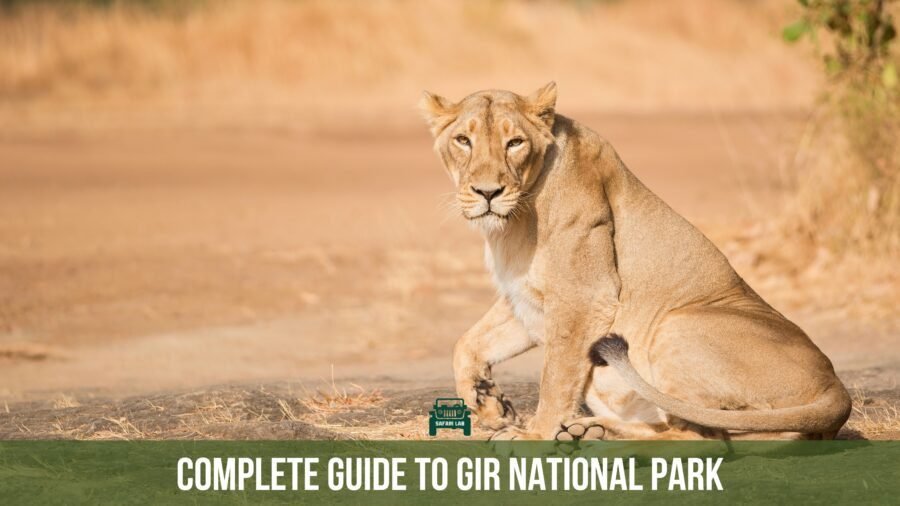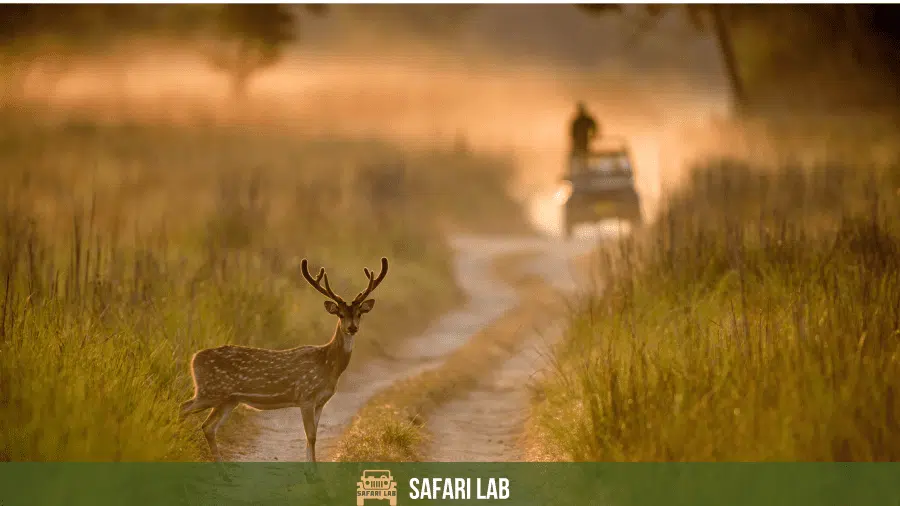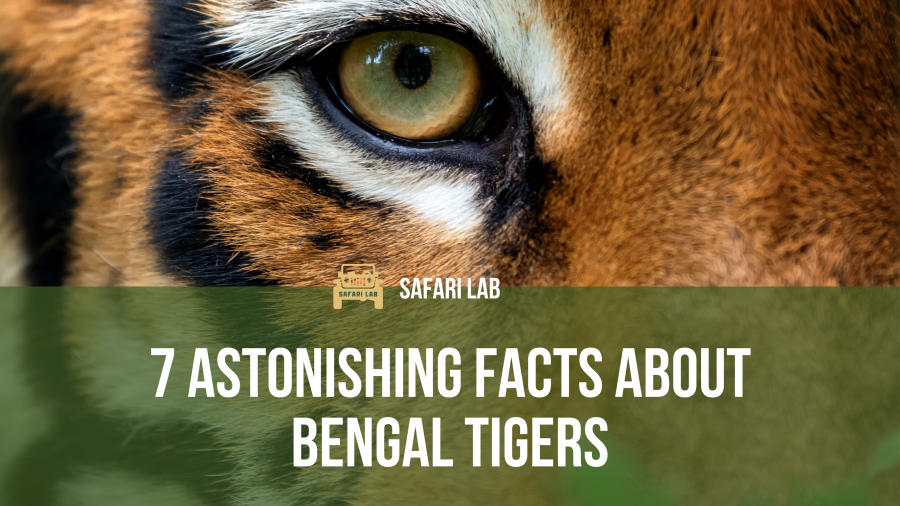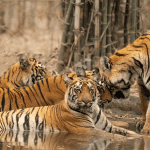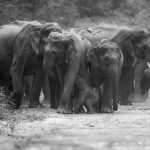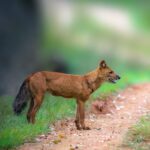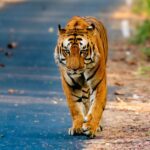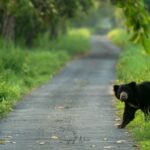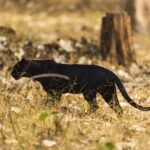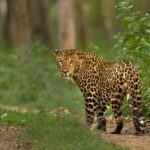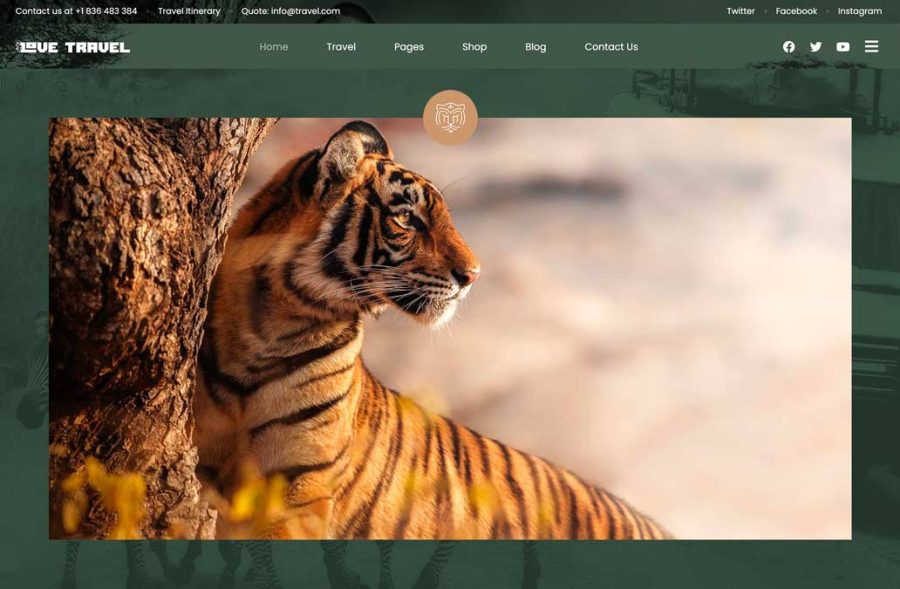In the vast and sunbaked landscapes of western India, tucked within the arid embrace of Gujarat, lies a forest like no other — Gir National Park, the final stronghold of the Asiatic lion.
This is not the Africa of sweeping savannahs and thunderous wildebeest herds. No. This is Sasan Gir — a realm of teakwood thickets, thorny scrublands, and dust-laced trails, where a rarer kind of lion treads. Smaller, leaner, and perhaps wiser for it, these are the survivors of a near-forgotten lineage. The last of their kind.
To walk beneath the canopy here is to walk back through time. Once, these lions roamed from the fringes of Greece to the heart of India. Today, they endure — not in zoos, not in fenced enclosures, but in the wild, proud and free, as nature intended.
And their numbers are rising.
According to the 2025 Asiatic Lion Census conducted by the Gujarat Forest Department, there are now 891 lions thriving in the Gir landscape — an extraordinary increase from just 674 five years prior. These lions inhabit not only the protected core of Gir National Park, but have also ventured into neighboring forests, coasts, and even human-dominated landscapes, revealing a story of survival and coexistence that defies all odds.
But Gir is more than a sanctuary. It is a living, breathing ecosystem — a rare confluence of forest and farmland, predator and pastoralist. It is home to leopards, hyenas, rusty-spotted cats, crocodiles, and over 300 species of birds that etch vibrant streaks across its skies.
In this guide, we shall explore the soul of this forest:
- When to come, and how best to see it
- Where to stay — from humble forest lodges to palatial safari resorts
- And how to prepare for an encounter with India’s most regal predator
So let us begin — not with noise, but with a reverent whisper. For in Gir, one does not simply visit. One listens. One watches.
And if fortune favours you… one beholds the lion.
Gir National Park – The Last Refuge of the Asiatic Lion
Gir National Park is the only place on Earth where the Asiatic lion roams free in its natural habitat. While the park itself covers approximately 258.7 square kilometers, it forms the core of a much larger conservation area—the Gir Wildlife Sanctuary, which spans 1,153 square kilometers. Together, these areas create a protected expanse of forest, grassland, and riverine habitat in Gujarat’s Saurashtra region. In addition, adjacent zones such as Mitiyala and Pania Wildlife Sanctuaries provide crucial buffer space for the movement of lions, leopards, and other wide-ranging species.
For visitors on limited time or seeking a more predictable wildlife experience, the Devaliya Safari Park offers a fenced safari experience. While it lacks the unpredictability of a full jungle trail, it often guarantees sightings of lions, deer, and other fauna.
A Changing Landscape: Gir National Park’s Zones, Rivers, and Dry Deciduous Charm
Though located in a semi-arid region, Gir Forest supports surprisingly diverse ecosystems. The dominant forest type is dry deciduous, featuring teak, jamun, babul, flame-of-the-forest, and various acacia species. Thorny scrublands and patches of savannah-like grassland serve as grazing grounds for the park’s herbivores, including chital, nilgai, and sambar.
Several perennial rivers—such as the Hiran and Shetrunji—crisscross the park, creating riparian belts that add crucial water sources. During dry months, artificial waterholes installed by the forest department also help sustain wildlife.
This blend of forest, scrub, and wetland environments makes Gir a rich mosaic of habitats, supporting not only lions but an entire web of plant and animal life adapted to extreme seasonal variation.
More Than Lions: Wildlife You’ll Encounter in Gir Forest
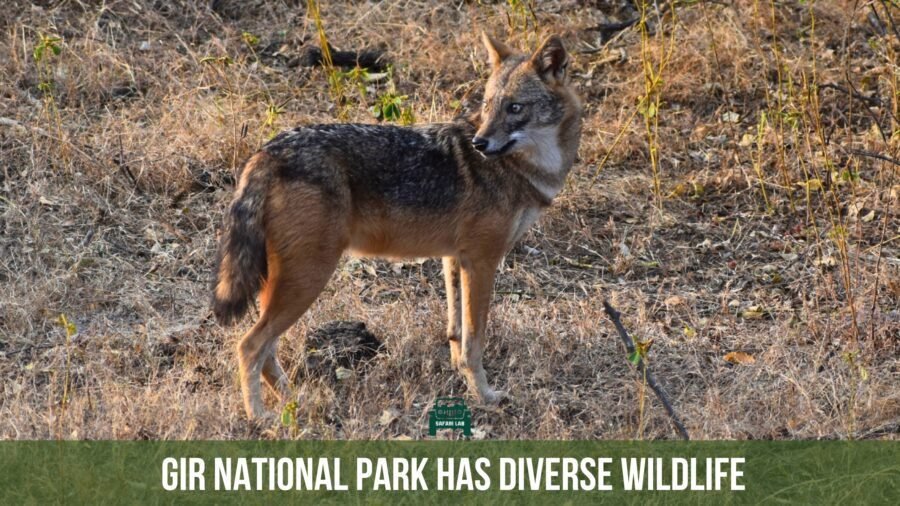
Although the Asiatic lion is Gir’s headline species, the forest supports a wide range of other wildlife. Mammal diversity includes 39 documented species, such as leopards, striped hyenas, golden jackals, jungle cats, rusty-spotted cats, and the elusive Indian pangolin. Reptile life thrives too, particularly the mugger crocodile, which populates the park’s rivers, reservoirs, and wetlands.
Over 300 species of birds have been recorded in Gir National Park, making it a hotspot for both resident and migratory birds. Visitors can expect to see raptors like the crested serpent eagle and changeable hawk-eagle, as well as colorful residents like the Indian paradise flycatcher. During winter, the park becomes a haven for migratory species, adding to its avian diversity.
Gir’s biodiversity doesn’t end with vertebrates—over 2,000 insect species have been catalogued, contributing to pollination, decomposition, and overall ecological balance.
Coexisting with Lions: The Maldhari Communities of Sasan Gir
One of the most unique aspects of Gir Forest is its long-standing human-wildlife coexistence model. The Maldhari tribes, semi-nomadic pastoralists, have grazed their livestock in these forests for generations. Though they share their environment with large predators, including lions and leopards, conflict levels are surprisingly low. Compensation schemes for livestock losses, along with conservation education programs, have helped maintain this delicate balance.
Unlike many parks where relocation of forest communities is the norm, Sasan Gir continues to experiment with coexistence, allowing Maldharis to live and work within designated zones of the sanctuary under regulated conditions.
Safeguarding the Pride: Conservation Efforts in Gir National Park
Gir’s conservation success is supported by ongoing scientific monitoring and habitat management. The Gujarat Forest Department uses satellite telemetry, camera traps, and individual lion identification databases to track the movements and health of the Asiatic lion population. Recent years have also seen an emphasis on genetic studies and wildlife health assessments to ensure long-term viability.
Programs focused on water conservation, prey base improvement, and habitat restoration have contributed significantly to the recovery and expansion of the lion population. As of the 2025 Asiatic Lion Census, the population stands at 891 individuals, a remarkable rebound from the near-extinction numbers of the early 1900s.
Why Gir is a Living, Breathing Model of Lion Conservation in India
Gir National Park is not just a sanctuary—it is a model of ecological resilience and adaptive conservation. It shows what’s possible when government agencies, local communities, scientists, and tourists work together. With its growing lion population, thriving biodiversity, and a rare example of coexistence between humans and predators, Gir continues to serve as India’s most successful big-cat conservation story.
In a world where wildlife habitats are shrinking, Gir remains an oasis where the natural order still holds—and where the lion, against all odds, still reigns supreme.
Planning a Lion Safari in India? Here’s Why Gir National Park Stands Alone
There are few places on Earth where time seems to stretch back to a wilder age. And in India, that place is Gir National Park. While the tiger may rule the forests of central and southern India, here in Gujarat, it is the Asiatic lion that claims dominion — and Gir is the only place on the planet where you can see these rare creatures in the wild.
When people search for a lion safari in India, they are really searching for Gir. Unlike Africa, where lions are plentiful and spread across vast plains, India’s lions are elusive, forest-dwelling cousins, protected fiercely in this dry deciduous sanctuary. No other park in the country — not Ranthambore, not Bandhavgarh, not even the Sundarbans — offers the opportunity to watch wild lions stalking through the underbrush, their manes catching the golden light of an Indian dawn.
In Gir, it is not just a safari. It is a pilgrimage to witness survival, adaptation, and perhaps one of the world’s most extraordinary conservation turnarounds.
Asiatic Lions vs African Lions: What Makes the Gir Safari Experience Unique
The lion of Gir is not quite the lion most imagine. Panthera leo persica, the Asiatic lion, is smaller than its African relative, with a less developed mane, a distinctive fold of skin along its belly, and a quieter, more secretive nature. It is also, by genetic lineage and habitat preference, wildly different.
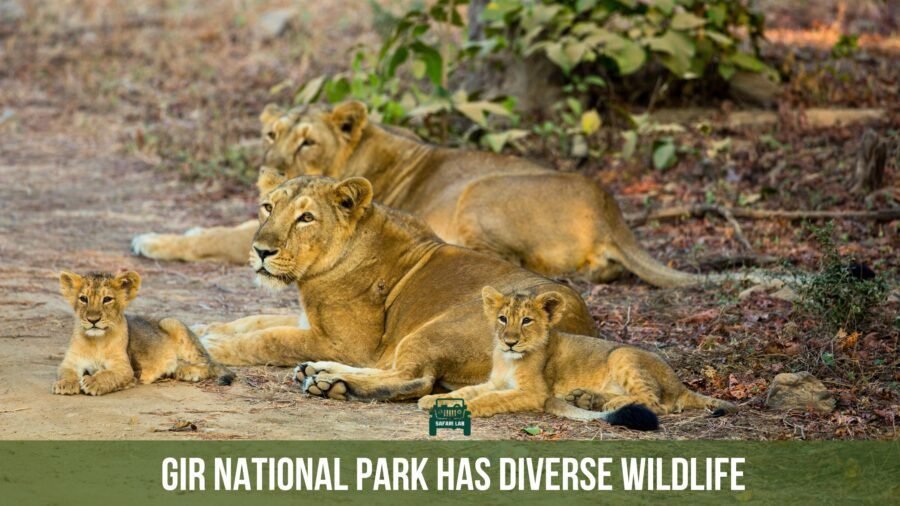
African lions dominate open savannahs in prides of up to 30. Asiatic lions, by contrast, are more solitary or live in small family units. They move through dense brush and acacia thickets, their golden coats melting into the dappled forest floor. This behaviour makes spotting them all the more thrilling — for they are not handed to you on a silver platter. You must listen, watch, and wait.
A safari in Gir is not a cinematic chase scene. It is a slow unraveling of the forest’s story, where each sighting feels earned, rare, and deeply personal.
Devaliya Safari Park vs Gir Jungle Trail: Which Lion Safari Should You Choose?
For anyone planning a lion safari in Sasan Gir, the first question is often a practical one: should you book the Gir Jungle Trail, or visit the Devaliya Safari Park?
Here’s the short answer:
Devaliya is better for last-minute visitors, families, and casual tourists.
The Jungle Trail is for serious wildlife lovers willing to invest time, money, and patience.
The Devaliya Safari Park, also known as the Gir Interpretation Zone, is a fenced 412-hectare enclosure carved out of the sanctuary. It offers a compressed version of the Gir experience — with lions, leopards, spotted deer, and wild boar all living inside a secure, accessible area. Since vehicles don’t need special permits and entry slots are more easily available, Devaliya is ideal for:
- Weekend tourists on a tight schedule
- Families looking for a quick, guaranteed wildlife sighting
- Those visiting during peak season when Jungle Trail permits are sold out
It’s cheaper, easier to book, and sightings are virtually guaranteed.
On the other hand, the Gir Jungle Trail is the true, open-forest safari — no fences, no shortcuts. Permits are limited, prices are higher, and bookings must be made weeks (sometimes months) in advance, especially during holidays. But the payoff is enormous: it’s here that you might follow fresh pugmarks through a dry riverbed, hear a roar echo at dawn, or stumble upon a lioness teaching her cubs to stalk.
It’s not just a ride — it’s a wild experience, and it demands something in return: patience, flexibility, and a willingness to leave with stories rather than snapshots.
If you’re a first-time visitor, unsure of your interest level, or planning last minute, Devaliya is a safe and satisfying option.
But if you came for the real thing — the unscripted drama of India’s last lions in the wild — then there’s no substitute for the Jungle Trail.
Famous Lions of Gir
Gir isn’t just home to over 891 Asiatic lions — it’s also the stage for legendary individuals who have come to define their territories, challenge rivals, and leave behind memorable encounters. These lions, though wild and unnamed in official records, have become well-known to guides, locals, and repeat visitors. Here are a few of Gir’s most recognised individuals.
Jay & Veeru – The Iconic Coalition
Jay and Veeru were one of the most famous male coalitions in Gir, often seen patrolling together across territories near Malanka, Kasia Ness, and Gadharia. They were dominant for several years, known for their size and strong bond. Veeru died in June 2025 due to injuries from a territorial fight, and Jay reportedly died a few weeks later, bringing their powerful chapter to a close.
Ram – The Oldest Lion in Gir
Ram earned recognition as one of the oldest known lions in the park’s history. He was often seen alone in the later years of his life, moving slowly through his territory. His longevity was exceptional for a wild lion and he eventually passed away of natural causes, as reported by forest authorities.
Salman – Dominant Male of Devadungar
Salman is a well-built male lion often spotted near the Kamleshwar Dam and Devadungar areas of Gir. Recognised for his thick mane and calm demeanour, he has held a consistent territory in recent years. As of mid-2024, he remained active and was frequently sighted around watering holes, especially in the warmer months.
Karan & Arjun – Brothers of Mahuya
This pair of male lions gained local recognition in the Mahuya area of Gir. They were often seen together, believed to be siblings or part of the same coalition. Their behaviour reflected typical young male dynamics—exploring new areas, challenging rivals, and gradually establishing their presence. Their current status is not officially documented, but they remain a popular reference among local trackers.
Puncture Wali Sinhan – The Tyre-Flattening Lioness
Known for her unusual behaviour, this lioness gained attention after repeatedly deflating safari vehicle tyres in Devaliya Park. She was often seen approaching parked jeeps and pressing down on tyres. This rare behaviour became widely known among guides and visitors alike. She is still believed to be active in the area
Gir Safari Price, Ticket Booking, and How to Plan Your Visit
Planning a Gir safari involves more than picking a date and hoping to spot lions. You’ll need to choose between safari types, understand time slot logistics, secure permits in advance, and plan accommodation around your safari timings — all while staying within budget. Whether you’re a weekend traveller or a seasoned wildlife photographer, this section breaks down exactly how to plan your visit: from booking the right safari slot to structuring an ideal 2-night trip and understanding what a Gir safari package typically includes.
How to Structure the Perfect 2-Night Gir Safari Itinerary
If you want more than a rushed drive-through of lion country, your best bet is a 2-night trip with 3 core zone safaris. It’s the sweet spot — giving you enough time to cover different safari routes, multiple time slots, and increase your chances of seeing lions, leopards, and more.
Here’s what that looks like:
Day 1: Arrive by noon → Check-in → Afternoon safari
Day 2: Morning safari → Rest → Afternoon safari
Day 3: Depart or add another safari if extending
This format works for first-time visitors, families, and photographers alike. If your goals include bird photography, multiple leopard sightings, or documenting lion behaviour across time slots, a 3–4 night stay with 5–6 safaris is ideal.
Whether you’re booking independently or searching for a Gir safari package, this 2N/3-safari base plan is the most time-efficient and rewarding option for a wildlife-focused visit.
Gir Safari Ticket Booking: What You Need to Know
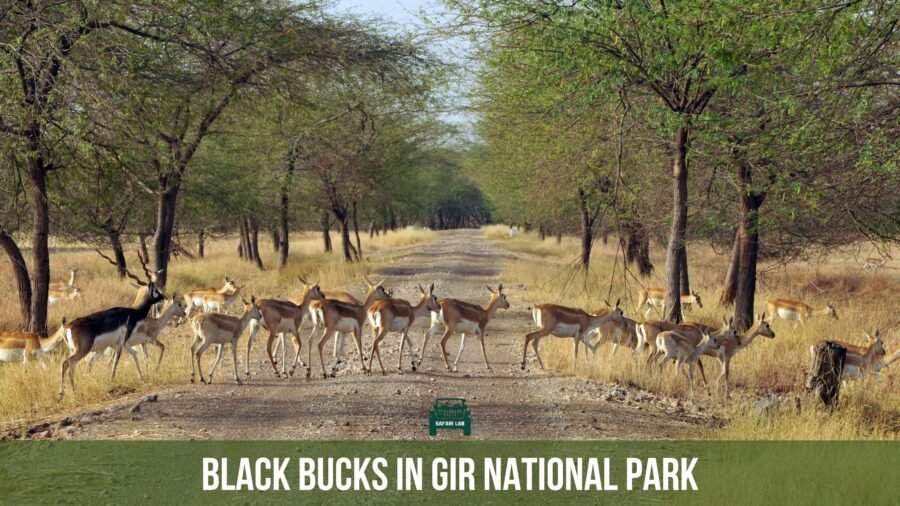
Permits for the Gir Jungle Trail must be booked in advance through the official Gujarat Forest Department portal. Each safari is booked per vehicle (not per person), and requires you to enter valid ID details for all participants at the time of booking.
You’ll need to:
- Select your preferred time slot
- Choose number of people (up to 6 per Gypsy)
- Carry the exact same ID used during booking at check-in
It’s smart to book core zone safaris first, then arrange your accommodation and travel around the confirmed slots. Many travellers make the mistake of doing it the other way around and end up without safari permits during peak season.
You can also opt for a Sasan Gir tour package that includes permit handling, driver-naturalist coordination, and pre-scheduled safaris — a good choice if you’re coming from out of state or want to avoid booking errors.
Best Time Slot for Gir Safari: Early Mornings Offer the Best Action
Each day, Gir offers three core zone safari slots:
- Slot 1 (Morning): 6:30 AM – 9:30 AM
- Slot 2 (Late Morning): 9:30 AM – 12:30 PM
- Slot 3 (Afternoon): 3:00 PM – 6:00 PM
In summer, timings shift slightly earlier to beat the heat.
The first morning slot is by far the most popular — lions are more active, the light is softer, and the temperature is more comfortable. If lion sightings are a priority, this is the one to aim for. The second morning slot is quieter and great for birds and smaller mammals, while the afternoon slot offers golden light but warmer temperatures.
If you’re doing 3 safaris, try to book across multiple time slots to experience how the forest changes through the day — and improve your chances of seeing different species.
Gir Safari Package Options: From Short Trips to Custom Wildlife Stays
There’s growing demand for Sasan Gir safari packages that combine stay, meals, and core zone safaris into a seamless experience. These packages are especially useful if:
- You’re coming from Ahmedabad or Rajkot and want a pre-arranged plan
- You don’t want to manage separate permit bookings
- You’re short on time and want to maximise sightings
A typical Gir tour package includes:
- 2 or 3 nights accommodation at a resort near Sinh Sadan (park gate)
- 2 to 6 core zone safaris in private or shared Gypsies
- Park entry fees, guide charges, and permits
- Optional: Transfers, meals, add-ons like Devaliya Park or tribal village visits
Operators like Safari Lab specialise in wildlife-first itineraries. Whether you’re planning a focused lion photography trip or simply want a smooth booking experience with pre-scheduled permits and vetted naturalists, working with a niche safari planner can save you time and avoid surprises.
Look for packages that include confirmed permits, not just promises — permit availability is the real bottleneck, especially from November to March.
Planning Tips for Your 2-Night Gir Safari
- Book permits first. Without core zone safaris, there’s no point booking a stay.
- Stay near Sinh Sadan, the main safari gate, for easier pickup and drop-off.
- Use all three time slots over your trip to increase sighting variety.
- Pack layers. Mornings are chilly, afternoons hot, especially in winter.
- Build in buffer time around each safari — being late means forfeiting your slot.
A 2N stay with 3 safaris gives most travellers a full experience of Gir — but if you leave wanting more (and you likely will), you’ll know how to plan a longer return
How to Reach Gir National Park
Getting to Gir National Park is straightforward, but your route will depend on where you’re starting and how much time you’ve got. Whether you’re coming from Ahmedabad, flying into Diu, or driving in from Rajkot, here’s how to make your journey smooth and safari-ready.
Nearest Airport to Gir Forest
The nearest airport to Gir Forest is Diu Airport, around 69 km from Sasan Gir. It’s the most convenient option for travellers flying in from Mumbai or other western cities, though flights are limited.
For better connectivity, especially from metro cities, Rajkot Airport (around 160–170 km) and Ahmedabad International Airport (330–370 km) are more practical. From both, road transfers are available via private taxis or pre-arranged pickups in most Gir tour packages.
By Train and Road: Veraval, Junagadh, and Beyond
If you prefer rail, the closest stations are Veraval (45 km) and Junagadh Junction (60 km), both well connected to cities across Gujarat and western India. From either station, it’s a 1 to 1.5 hour road journey to reach Sasan Gir.
Gujarat’s highways are in excellent condition, and road travel is often a scenic, reliable choice — particularly if you’re arriving as part of a Sasan Gir tour package from Ahmedabad.
Driving to Sasan Gir: Road Distances from Key Cities
If you’re planning a self-drive or chauffeur-driven trip, here’s what to expect:
- Ahmedabad to Sasan Gir: 6–8 hours (330–370 km)
- Rajkot to Sasan Gir: 3–4 hours (160–170 km)
- Diu to Sasan Gir: 2 hours (approximately 70 km)
Many Sasan Gir safari tour packages include transport from Ahmedabad, especially for 2N/3D itineraries. This saves time and ensures your safari permits and transfers are all coordinated.
Plan Your Arrival Around Safari Time Slots
If your plan includes a 2-night safari package with three core zone safaris, your arrival time matters. Ideally, reach Sasan Gir by noon on Day 1 to check in, rest, and head out for your first afternoon safari.
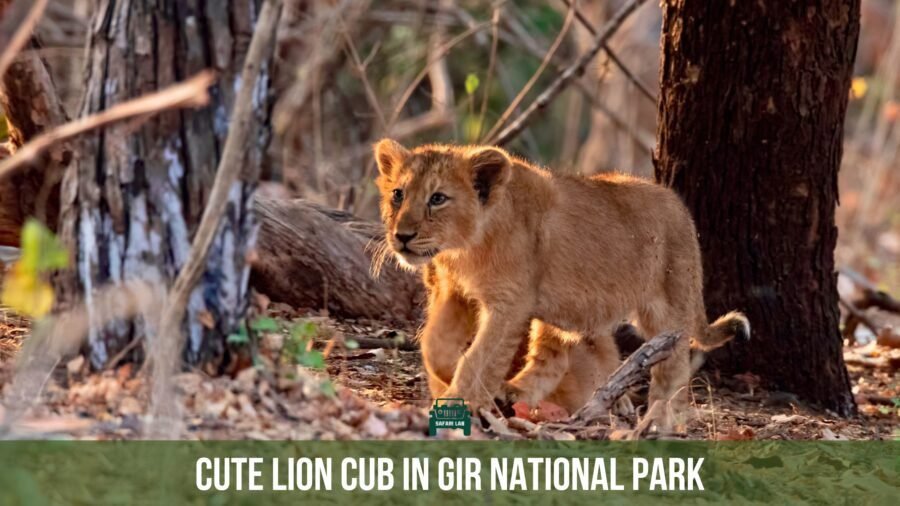
If you’re booked for the morning safari on Day 2, consider arriving the evening before. Travelling the same morning can be stressful — especially with the early start time and check-in requirements.
Whether you travel by air, rail, or road, always allow buffer time before your first safari. In Gir, missing a time slot means missing a major part of your experience — and late arrivals are non-refundable.
Where to Stay: Gir Safari Resorts, Homestays & 5-Star Options
Choosing the right stay near Gir National Park isn’t just about comfort — it directly affects your safari experience. Since safaris start from the Sinh Sadan gate in Sasan Gir, the closer your resort or homestay is to the gate, the easier and cheaper your safari transfers become. Many gypsy drivers charge extra for pickups from accommodations farther away, especially during early morning slots. So, whether you’re looking for a luxury retreat, a mid-range base, or a rustic homestay, proximity matters.
Here’s a handpicked mix of Gir safari resorts, Sasan Gir 5 star resorts, and homestays — all within practical range of the safari gate — suited for different travel styles and budgets.
Sasan Gir 5 Star Resort Options
If you’re looking to pair your lion-spotting with five-star luxury, these resorts deliver both comfort and convenience. All are within a 2–4 km radius of the Sinh Sadan gate, making them ideal for seamless early-morning safari access while offering top-tier hospitality. Perfect for couples, families, or travellers booking premium Sasan Gir resort packages.
The Fern Gir Forest Resort (Approx. 1.8 km from gate)
A polished, well-managed 5-star resort set close to the safari zone. The Fern offers forest-themed cottages, a pool, spa, and eco-conscious service — and more importantly, quick access to Sinh Sadan. This is one of the most popular choices for premium travellers who want minimal transfer time and high-end comfort. Ideal for those booking a Sasan Gir 5 star resort package with safaris included.
Woods at Sasan (Approx. 2.5–3 km from gate)
A boutique luxury resort known for its wellness-first approach, blending forest immersion with Ayurvedic treatments, yoga, and gourmet dining. It’s slightly farther than Fern but still close enough for hassle-free safaris. Ideal for couples and photographers wanting a tranquil, design-led experience between safaris.
The Postcard Gir (Approx. 3.5–4 km from gate)
Stylish villas surrounded by mango orchards and wilderness, with curated activities like nature walks and vintage jeep rides. The Postcard brand is known for elegant, minimalist hospitality. Though a bit removed from the central safari hub, it’s a great pick for those who value experience over proximity.
Mid-Range Gir Safari Resorts
These resorts strike a great balance between price and comfort, often featuring in popular Gir safari packages and Sasan Gir tour packages from Ahmedabad. Most are within a 2–4 km distance of the gate, offering decent amenities, helpful staff, and reliable safari coordination — without the five-star markup.
Gir Jungle Lodge (Approx. 2.6 km from gate)
A classic mid-range resort located near the forest boundary, this property is often booked in Gir tour packages for its convenience and comfort. It offers AC cottages, a pool, and functional safari support. Great for families and small groups looking for value without compromising on access.
Saavaj Resort (Approx. 3–4 km from gate)
A solid mid-range option, especially for larger groups and families. Saavaj offers multiple room categories, outdoor spaces, and basic amenities. It’s not ultra-close, but still a short drive to the safari gate.
Mahavan Resort (Approx. 2–3 km from gate)
Located along the Talala–Sasan highway, Mahavan is a lower mid-tier resort that offers clean rooms and proximity to nature. Ideal for travellers looking for an economical stay that doesn’t sacrifice location. Good for short trips where the focus is mainly on safaris.
Homestays Near Gir National Park
For those looking to experience Gir with a local touch, these homestays offer simplicity, warmth, and easy gate access — usually within 2–5 km of Sinh Sadan. They’re ideal for budget-conscious travellers, backpackers, solo explorers, or anyone who wants to experience authentic Saurashtra hospitality.
Kalash Homestay (Approx. 3.8 km from gate)
One of the better-rated homestays in the area, Kalash offers a quiet, no-frills experience with warm hosts and home-cooked meals. Its proximity to the gate makes it ideal for early morning safari-goers on a budget. Great for solo travellers or couples.
Dev’s Den Homestay (Approx. 4–5 km from gate)
Tucked into the forest edge, Dev’s Den offers a more immersive, rustic setting with fewer rooms and a calm atmosphere. It’s a good pick for nature lovers or photographers who want solitude and don’t mind a slightly longer transfer.
Gokul Farm Housee (Approx. 2–2.5 km from gate)
A local homestay with farm-style accommodation, just a short drive from Sinh Sadan. It offers simple rooms, basic facilities, and early access for those morning safaris. Ideal for backpackers, students, or anyone wanting to experience Gir on a budget.
How to Choose Your Gir Safari Stay
- Closest to gate: The Fern, Gir Jungle Lodge, and Gokul Farm Housee all lie under 3 km from Sinh Sadan. This means minimal gypsy transfer charges and quicker access for morning safaris.
- For luxury with experience: Woods at Sasan and The Postcard Gir offer unique ambiance and high-end service for longer or wellness-oriented stays.
- For tour packages: Mid-range options like Saavaj Resort and Mahavan often feature in Gir safari packages and Sasan Gir tour packages from Ahmedabad, combining cost-efficiency with convenience.
- For local vibe: Kalash, Dev’s Den, and Gokul Farm Housee offer warm hospitality, lower prices, and proximity — but with simpler infrastructure.
Whether you’re planning a focused photography trip or a quick weekend getaway, matching your resort’s location to your safari timing is key. Booking a well-located stay as part of a complete Gir tour package can save you the stress of coordinating permits, transfers, and early-morning logistics — and ensures you don’t miss your lion by a few dusty kilometers.
Frequently Asked Questions about Gir National Park
Here are the most frequently asked questions about Gir National Park, curated to help you plan smarter, travel easier, and get the most out of your safari experience.
What is the cost for a safari at Gir National Park?
Safari prices vary by visitor category and vehicle type. For Indian nationals, a core zone jeep safari costs around ₹5,500–₹6,000 per vehicle (up to 6 people), inclusive of permit, guide, and gypsy charges. For foreign tourists, rates go higher due to differential permit fees. Devaliya Safari Park is cheaper, typically under ₹1,500 per person.
How do I book a jeep safari at Gir?
You can book Gir Jungle Trail safaris online through the official Gujarat Forest Department portal. Advance booking is mandatory and requires valid photo ID details for all guests. Tour operators offering Gir safari packages often include permit handling and vehicle booking.
Which time slot is best for a Gir safari for lion sightings?
The early morning slot (around 6:30 AM) is generally considered the best. Lions are more active, the forest is quieter, and temperatures are cooler — all of which improve your chances of a sighting.
Can I join a Gir safari at the last minute?
It’s possible only if permits are still available — which is rare in peak season. Devaliya Park allows easier last-minute access. For core zone safaris, booking at least 3–4 weeks in advance is strongly recommended.
What is the nearest airport to Gir Forest?
Diu Airport is the closest (approx. 70 km), but has limited connectivity. Rajkot Airport (160 km) and Ahmedabad Airport (370 km) offer better flight options and are more commonly used by travellers.
How far are safari resorts from the Sinh Sadan gate in Sasan Gir?
Top resorts like The Fern Gir and Gir Jungle Lodge are within 2–3 km of the Sinh Sadan gate. Mid-range resorts and homestays range from 2 to 5 km. Proximity affects your gypsy pickup charges, so closer stays are ideal.
Which is better — Gir Jungle Trail or Devaliya Safari Park?
The Gir Jungle Trail is the core safari experience — it offers real-time tracking and wild lion sightings but requires advance planning. Devaliya is a fenced zone with guaranteed sightings, better for quick visits or travellers with time constraints.
Are private vehicles allowed inside Gir National Park safari zones?
No. Private vehicles are not allowed inside the core safari zones. Only registered forest department gypsies with certified drivers and guides can operate inside the park.
What should I pack and expect on a Gir safari trip?
Pack light layers, a hat, sunscreen, binoculars, and valid photo ID. Expect bumpy forest tracks, early morning starts, and no guarantees of lion sightings — patience is key. Also, mobile network is patchy inside the park.
Does a “Gir safari package” include accommodation and meals?
Safari Lab’s Gir tour packages include accommodation, meals (AP plan), safari permits, gypsy charges, and guide fees. Always check if your package includes confirmed safari permits — especially in peak season
Conclusion: Why Gir National Park Should Be on Your Wild List
Gir is more than just the only place in the world where Asiatic lions still roam free — it’s a tapestry of dry deciduous forests, rugged terrain, and raw, untamed India. Whether you’re chasing rare wildlife sightings, planning a family trip, or exploring Gujarat’s wild side on a Sasan Gir tour package from Ahmedabad, the experience is equal parts thrilling and grounding.
A well-planned trip — with the right Gir safari package, correctly timed safaris, and accommodation close to the gate — can make the difference between a rushed checklist experience and a meaningful brush with the wild. So book those permits early, charge your camera batteries, and don’t forget your ID — the lions are waiting, and they don’t do retakes.
Let Safari Lab craft your perfect Gir adventure—expertly planned safaris, handpicked stays, and zero guesswork, so all you have to do is show up and spot the lion.

